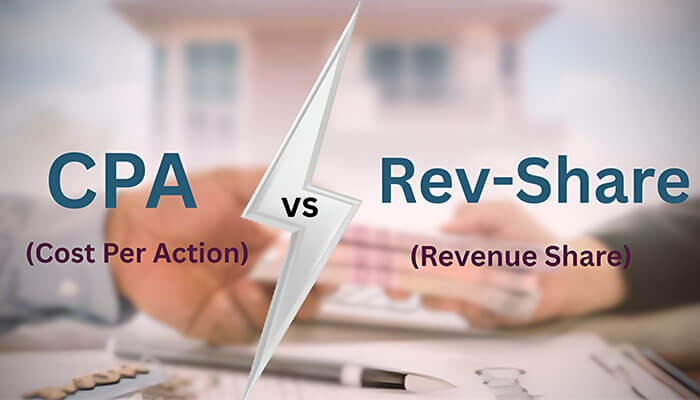shoppingshoppingWhen it comes to affiliate marketing in the finance space, especially around loans and credit, two models dominate the landscape: CPA vs. Rev-Share Loan Affiliate Programs. Both have their loyalists, and both can generate serious income — but the big question is: which model actually puts more money in your pocket?
The short answer? It depends on your traffic type, audience behavior, and risk tolerance.
Let’s break it down with real-world insight, not just theory.
Understanding the Basics: CPA vs. Rev-Share
What is a CPA Loan Affiliate Program?
With CPA (Cost Per Action), you get paid a fixed amount whenever a user completes a predefined action — typically a loan application or form submission.
For example:
You send traffic to a lender. If the user fills out a loan application, you earn $75. That’s it. Whether the loan is approved, funded, or repaid doesn’t impact your payout.
What is a Rev-Share Loan Affiliate Program?
Rev-Share means you earn a percentage of the revenue the lender generates from the customer you referred — usually tied to interest or fees paid by the borrower over time.
Let’s say your user is approved for a $1,000 payday loan. If the lender charges $300 in fees over the life of the loan and you’re on a 30% rev-share deal, you earn $90. However, this revenue might trickle in over weeks or months.
CPA: Fast Payouts, Lower Risk
One of the biggest advantages of CPA offers is predictability. You know exactly how much you’ll make per qualified lead.
Let’s say you’re running a comparison site that attracts users actively looking for emergency loans or bad credit financing. These visitors often convert well, and you can optimize aggressively with A/B testing. If your CPA rate is $80 per qualified application and you send 100 applications a day, you’re looking at $8,000 daily revenue — paid out weekly or even faster in some networks.
Why CPA Appeals to Most Affiliates:
- No wait for repayment or funding
- You get paid even if the lender doesn’t
- Great for media buying (native, push, Google Ads)
- Easier to scale fast with paid traffic
However, CPA offers typically come with strict rules:
- Minimum FICO score
- Specific geos (e.g., US-only, or even state-restricted)
- Fraud checks and lead quality reviews
If your traffic doesn’t meet the lender’s standards, you may get scrubs (non-payments) or worse, a ban.
Rev-Share: Higher Potential Earnings, But Delayed
Now let’s flip the coin.
Rev-Share can be extremely profitable — especially if you’re in it for the long haul. It rewards affiliates who send high-quality, loyal users who repay loans, renew them, or apply for new loans with the same lender.
A good loan company affiliate program (like Lead Stack Media) often has hybrid models or deep Rev-Share setups where affiliates earn commissions on renewals or rollovers, not just the initial funding. If a user takes a $500 loan and ends up repaying $900 over a few months (due to interest), your 25–35% cut could earn you $200+ — from one lead.
When Rev-Share Works Well:
- Organic traffic from finance blogs, YouTube, or SEO content
- Email lists of qualified borrowers
- Niche sites that focus on long-term financial help (e.g., “how to rebuild credit”)
But There’s a Catch:
- Delayed gratification — payouts may arrive 30–60 days later
- Dependency on lender retention — if they can’t collect, you don’t get paid
- Unpredictable revenue — it fluctuates based on user behavior
Rev-Share is not ideal if you’re paying for traffic upfront and need fast ROI. But it shines if you own the audience and have their trust.
Real-World Scenario Comparison
Let’s say two affiliates each send 1,000 visitors in a week.
Affiliate A (CPA model):
- Traffic: Paid Google Ads
- Offer: $80 per approved lead
- Conversions: 4%
- Revenue: 40 leads × $80 = $3,200
Affiliate B (Rev-Share model):
- Traffic: Organic blog + email list
- Offer: 30% rev-share
- Conversions: 3%
- revenue per funded user: $150
- Revenue: 30 users × $150 = $4,500, but paid over 30–45 days
So who wins?
Short term: Affiliate A — fast payout, more control
Long term: Affiliate B — higher lifetime value
Hybrid Models: Best of Both Worlds?

Many top-tier networks and lenders now offer hybrid affiliate deals — for example, $40 upfront + 10% lifetime rev-share. These are often negotiated one-on-one, especially if you bring quality traffic or volume.
Hybrid models let you recover ad spend quickly, while still earning passive income from long-term borrowers.
If you’re unsure where your audience fits, starting with hybrid offers can be a smart middle ground.
Which Model is More Profitable?
There’s no one-size-fits-all answer, but here’s how to decide:
| Criteria | CPA Model | Rev-Share Model |
| Payout speed | Fast (weekly or bi-weekly) | Delayed (monthly or after repayment) |
| Best for | Paid ads, fast scaling | Organic content, email lists |
| Predictability | High — fixed rate per lead | Low — depends on user repayment |
| Maximum earning per user | Capped (e.g., $60–$120 per lead) | Potentially high (>$200+ over time) |
| Risk | Low (no repayment dependency) | Higher (depends on lender performance) |
| Ideal for beginners | ✅ Yes | ❌ Not ideal unless you own the audience |
Affiliate Veteran Tips: How to Maximize Either Model
- Know Your Traffic Quality
If your visitors are just shopping around or looking for no-credit-check hacks, CPA might be safer. But if they’re ready to borrow and trust your brand, Rev-Share can outperform. - Test Before Scaling
Always test multiple offers across networks. What works with one lender may flop with another — even if both are CPA. Lead quality rules vary. - Talk to Your Affiliate Manager
Good networks (like Lead Stack Media) often offer better deals once you prove traffic consistency. Don’t hesitate to negotiate better CPA rates or a custom Rev-Share percentage. - Track Beyond the Click
Use tracking tools like Voluum, RedTrack, or even UTMs in Google Analytics to understand which sources deliver the most valuable users — not just clicks.
So, Which One Should You Choose?
If you need consistent, short-term revenue — go CPA.
If you want to build long-term passive income and have control over your audience — consider Rev-Share.
If you’re somewhere in between, ask your affiliate partner about hybrid deals. Many loan companies and networks are open to flexible terms — especially if you’re bringing real, converting users.
Final Thoughts
Whether you go the CPA route or chase recurring income with Rev-Share, both paths can be profitable — if you match the model to your strengths.
And remember: the best affiliates don’t just pick one. They test, adapt, and negotiate better deals as they grow.
Start with a trusted loan company affiliate program that gives you access to both CPA and Rev-Share options, and track what works best for your audience. That’s how pros build sustainable income in the competitive world of loan affiliate marketing.


